Ask a question from expert
Case Study on Organizational Learning & Development
21 Pages4478 Words279 Views
Added on 2019-11-26
Case Study on Organizational Learning & Development
Added on 2019-11-26
BookmarkShareRelated Documents
Organisational Learning & DevelopmentCase Study of MINDS Charity Retail Store Singapore
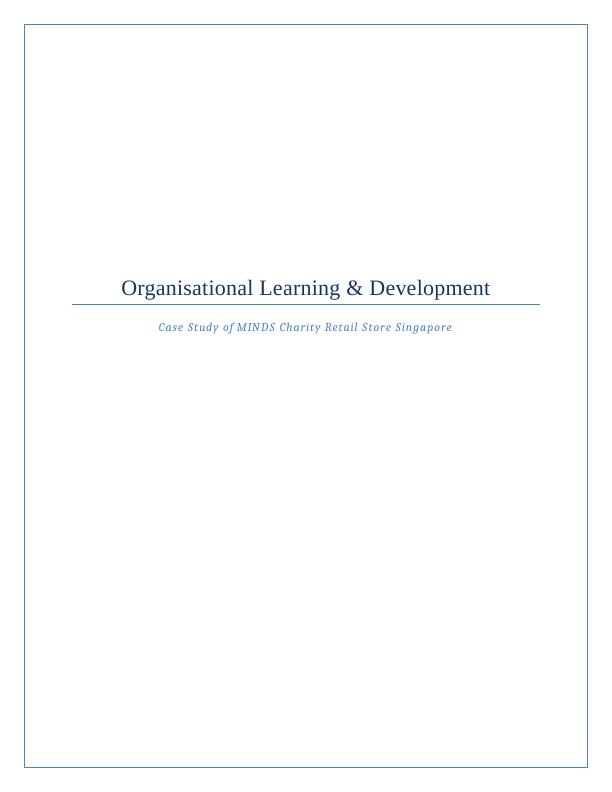
Table of ContentsIntroduction.................................................................................................................................................32. Organisational Context............................................................................................................................43. Analysis...................................................................................................................................................84. Design...................................................................................................................................................115. Delivery.................................................................................................................................................156. Evaluation..............................................................................................................................................157. References.............................................................................................................................................178. Appendices............................................................................................................................................19
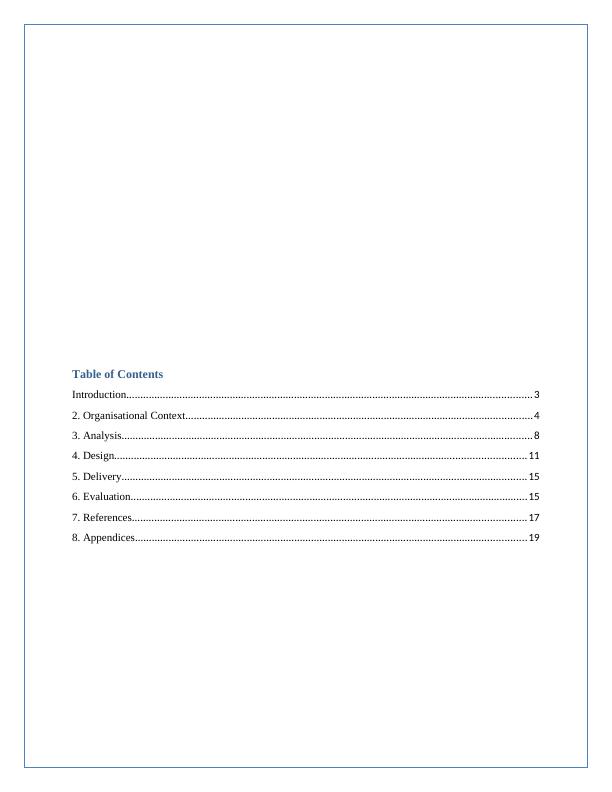
IntroductionAn organisation works best when there is a learning culture established in the organisation. In thecontemporary market scenario it is important that every organisation becomes a learningorganisation allowing each and every member to learn while they work consistently for theorganisation. It is important to note that all the established and successful multinationals arefocused on improving their learning culture within the organisation which helps them to makesure the employees could learn constantly while being at work. Learning and development of theemployees is one of the main focus of the established organisations for the right reasons aspractically acquired knowledge helps the employees to perform to the best of their abilities.Employee training and development stands to be essential program for the organisations as it willhelp the employees to strong and professional which is important for the organisation to performeffectively and gain competitive advantage (Hitt, Ireland and Hoskisson, 2012). Even for the charity retail employee knowledge and efficiency is important since it helps them toperform well and engage people to show interest in buying from charity retail stores fordevelopment of the society. Continual learning within the organisations stands to be importantsince it contributes to the substantial personal and professional development of the employeesand helps the organisation to meet the target objectives successfully. In the present learning anddevelopment report the main focus will be on enhancing the organisational and professionalskills of the employees which would help to make sure they are able to perform well for theorganisation and generate significant revenue for the organisation as well (Argote, 2012). The company chosen for the undertaking of the learning and development report is MINDScharity Stores which does charity retailing mainly and tries to contribute to the overall socialwelfare of the organisation. MINDS charity stores are thrift shops where different kinds offurniture, cloths, collectibles et cetera which helps to generate money for charity. Hence thepresent learning and development scenario will help to infuse skills for increasing sales of thecharity stores, encourage participants to manage and handle diverse source of populationeffectively, to motivate and commit the employees to work for charity and effectively develop astronger vision for the development of the operations of the charity shop. The learners or traineesinvolved in this training and mostly volunteers involved with the charity and are willing to work
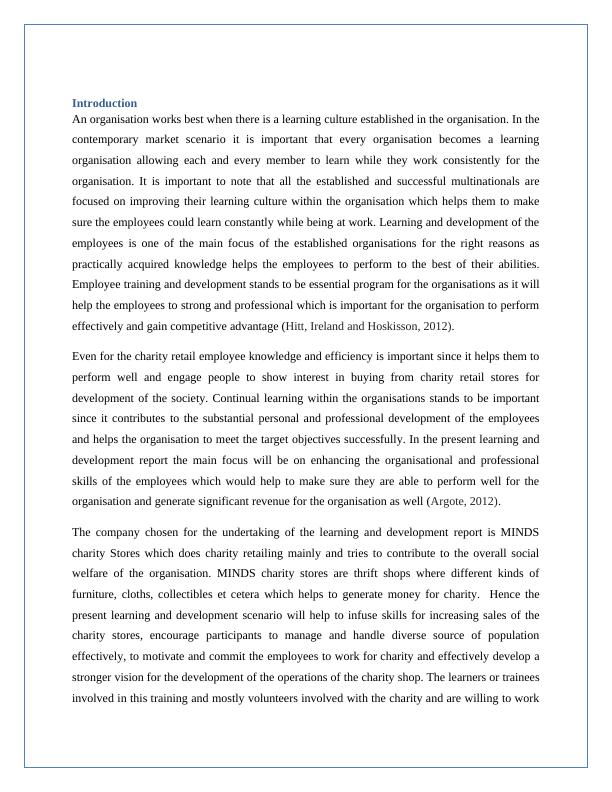
for the thrift shop. The present study will discuss the different roles and responsibilities involvedwith the learning and development scenario related to the case study of MINDS. The report willhighlight the use of different models and theories which would help to discuss learning anddevelopment closely and also take into account the key related aspects like costs and timescheduling, learning and development framework et cetera (Burgoyne, 2012). Overall it could besaid that the present report will discuss learning and development elaborately taking into accountthe case of MINDS charity retail store which would help to address the key objectives of thestudy successfully. 2. Organisational ContextLearning in organisation is important since improved learning in organisations will help to makesure the organisation is moving towards suitable and gradual development. It is important to notethat organisational learning and development is largely linked which clearly shows theimportance of learning in organisation. Organisational learning involves different strategies toempower employees with knowledge. In the present case it is important to note that MINDS is acharity store and in order to contribute to the health and welfare of the society it is important forthem to focus on improving the sales strategy of the organisation. In order to enhance the overallability of the organisation it is important that the key organisational principles are taken intoaccount while implementing the learning and development. In organisations training anddevelopment are mainly related to certain key aspects of the organisation which means thetraining and development approach follows certain key principles which have to be maintainedeffectively in order to impart knowledge to the volunteers of MINDS charity store (Burgoyne,2012). The principles which are undertaken for effective learning and development programdistribution are:Strategic: Moving with the strategic goals in mind for the organisation mainly helps to make surethe HRD needs are met relevant to strategic objectives of the organisation. In the present case thebusiness strategy of the organisation MINDS is to focus on reaching the consumers througheffective and suitable consumer service. The mission of the organisation is to encourage socialwelfare through sales of value for money. The Vision of the organisation is to constantly workon social welfare through activities. The business strategy mainly focuses on using volunteersand deploying them in the stores to sale items and contributes effectively to charity. The core
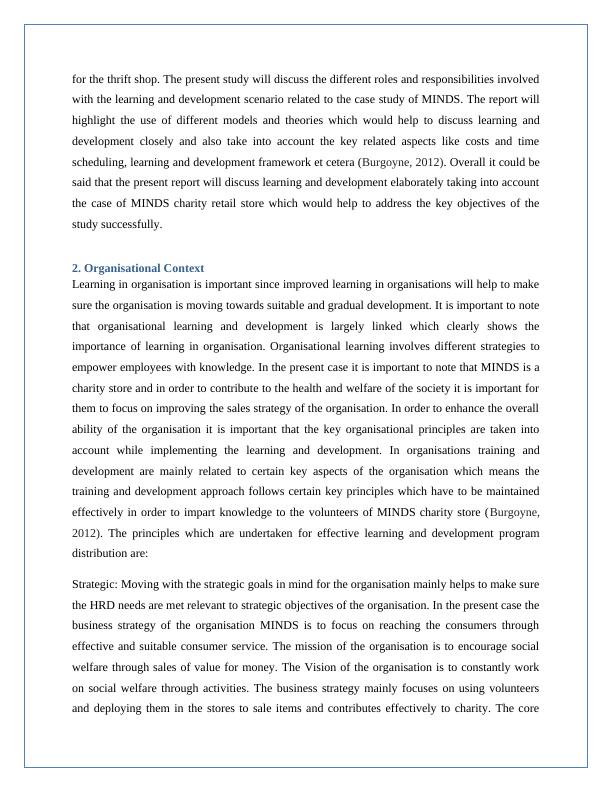
values of MINDS are: strength of character, mutual respect and understanding, integrity, lifelonglearning and excellence we aspire (Argote, 2012). As per Barham et al., (1988) (cited in Hitt, Ireland and Hoskisson, 2012) there are three differenttraining and development approaches which are used for imparting strategic learning likefragmented approach, formalised approach and focused approach. The fragmented approach is atime wasting approach without any focus, the formalised approach is slowly and steadily linkedto human resource needs and finally the focused approach of training and learning is effective forvolunteers working in MINDS where the learning is clearly focused on the strategic goals of theorganisation. Hence it is important to focus on focused learning approach for effective impartingof knowledge. Business Led: The business led factors are mainly related to the external PESTEL factors whichis extremely important to be discussed and understood by the volunteers working for MINDSshop. It is important that the volunteers understand the external factors in order to cope up withthe political, economic, social, technological and legal factors. The learning in these areas willhelp the volunteers to work accordingly. The business led factors mostly relate to the changingneeds of the organisation and hence it is important for the organisation MINDS to focus onimparting knowledge about mainly the political, economic and social factors which could changethe way business is done. These factors would help to improve the capability of the organisation.As per Barham et al., (1988) (cited in Hitt, Ireland and Hoskisson, 2012) PESTEL factorsinfluence the Learning and development needs of the volunteers as it emphasises more onproviding knowledge on communication with diverse groups, managing economic aspect of thebusiness where the formalised approach comes in handy. Horizontal Integration: The horizontal integration could only be achieved when the employeeshave ample knowledge about the expansion of business which needs communication. It isimportant to mention that providing knowledge on the strategic aspects of the business will helpMINDS to focus on increasing their chances to interest people to increase their attachment withcharity retail stores. It could be achieved with the help of knowledgeable and efficient people forwhich learning and development is important. The performance management of the organisationMINDS is horizontally integrated and it is done with the help of the different levels of training

process for instance induction, work related training, appraisal et cetera which helps to enhancethe internal knowledge base effectively. Structure and Culture: As per Handy (1985) (cited in Goetsch and Davis 2014) structure andculture of an organisation largely influence the learning and development of the organisation andhence it is important that structure and culture is decided prudently. The structure of theorganisation MINDS should be kept flat and hierarchical which would help to communicate andget knowledge effectively and the culture should be friendly role culture which would help eachand every member to realise their work and learn from the peers effectively. Adding Value: Adding value could be defined as the process of adding to the organisationalcapability to achieve its organisational goals and meet challenges. This could be done with thehelp of MINDS think tank. This includes the quality assurance system and the consumer serviceprovision processes are the two key aspects that add value to the organisation and its operations(Sessa and London, 2015).The costing consideration in this case would somewhat involve $300 for 40 volunteers for 2dayswhich means the total investment will be $12, 000. It is important to mention that thegovernment is providing 90% subsidy on the amount which means it will bear a total amount ofaround $10,800 and hence the final cost incurred by the organisation MINDS is only $1200.
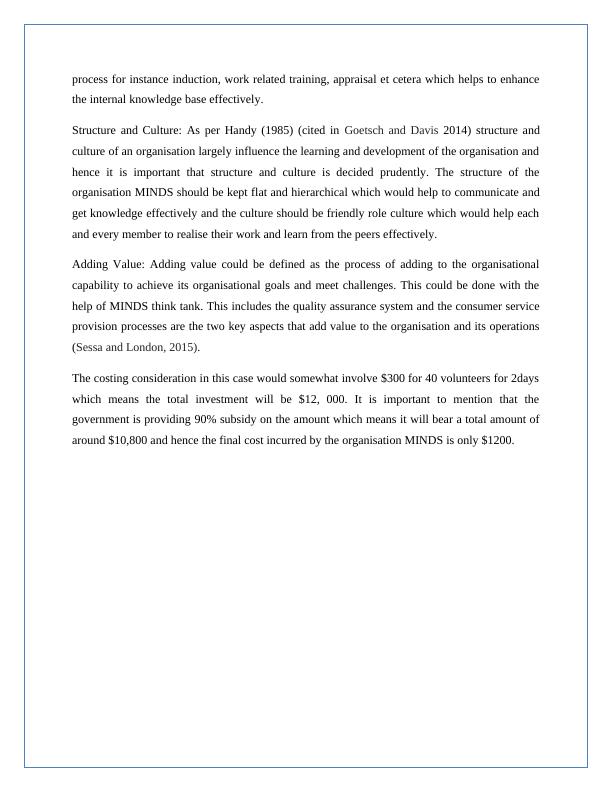
End of preview
Want to access all the pages? Upload your documents or become a member.
Related Documents
Leadership and Management: Key Theories and Perspectiveslg...
|9
|2742
|55
Organizational learning assignmentlg...
|24
|4893
|23
Inquiry Based Learning: Impact of Online Shopping Trend on Retail Industry - TK Maxx Case Studylg...
|8
|2291
|358
Developing Individuals Teams and Organisationslg...
|21
|5988
|137
CPD: Definition, Engagement, and Support in Organizationslg...
|19
|6519
|40
Differences between Organisational and Individual Learning, Training and Developmentlg...
|15
|4563
|87